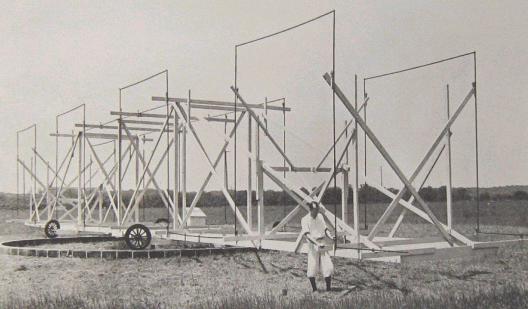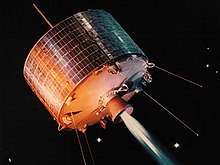Gegenschein is a phenomenon that can be seen in places with very dark skies. A faint spot of light appears on the ecliptic at a point directly opposite the Sun's current position, caused by sunlight reflecting from dust in space.
A fun way to get up to speed on space jargon, by proposing better meanings for exciting-sounding words from way way up beyond the atmosphere. There are many fabulous words used in the space business every day -- bring them into your workplace with you, fresh with new meanings, and impress your co-workers. With a nod to Douglas Adams and John Lloyd who did something much more powerful for placenames, this was inspired by The Snowball Herminator, who takes all credit and no responsibility.
2011-01-31
2011-01-28
Roche limit
This exotic-sounding term refers to the closest distance an orbiting body (held together only by its own gravity) can get to its parent planet before being torn apart by tidal forces. The Roche Limit is approximately 2.45 times the radius of the parent body. Also known as the tidal stability limit, but I think we can get more mystery and alternative meanings out of the name given it by the French astronomer Édouard Roche.
2011-01-27
Swingby
Swingby is the colloquial term for 'gravitational/gravity assist manoeuvre' or 'sling-shot'. The basic principle is to use the relative motion of a massive body (a planet usually) to steal some momentum in order to accelerate or decelerate a spacecraft. This sounds like cheating, but it really works. The velocity relative to the Sun can be changed, but the speed relative to the swingby planet stays the same. Optimising swingby plans is a fun challenge in astrodynamics.
You can read up on Gravity Assists in wikipedia, or elsewhere, including many excellent books.
As a real example of a swingby, check out this page for a good description and some vector diagrams of the Nozomi Earth Swingby manoeuvre. However the really classic example of this comes from the Voyager 2 Grand Tour:
| Spacecraft speed with spikes at each planet caused by swingby (note how the Jupiter swingby gave Voyager2 enough speed to escape the gravity of the Sun!) |
2011-01-26
Tunguska
Tunguska is a region within Siberan well known for being located under an asteroid that exploded in the atmosphere on 30 June 1908. The "Tunguska Event" flattened a vast area (over 2100km2) of forest and was felt thousands of kilometers away. Check out the reports, explosion estimate and eye witness accounts here.
2011-01-25
Zwicky
Fritz Zwicky was a Swiss astronomer who spent most of his professional life at Caltech making important theoretical and observational contributions. Mostly Zwicky is known for some of the more weird stuff in astronomy - supernovae, neutron stars, and galaxies acting as gravitational lenses. From 1961 to 1968 he and his colleagues published a 6-volume "Catalogue of galaxies and of Clusters of Galaxies", hence the "Zwicky Catalogue".
 |
| Fritz Zwicky (from Wikipedia) |
2011-01-24
Kick Motor
A Kick Motor is kind of 'single use' rocket engine used to put satellites into their (nearly) final orbit. After launch, satellites usually start in orbits that are limited by the performance of the launch vehicle, and also by principles of safe operations. Especially for moving into a geostationary orbit, a big single thrust is used to increase the size of the orbit (loosely speaking: the faster a satellite goes, the bigger the orbit - within limits). It is most energy-efficient to apply this thrust at the apogee (opposite of perigee) of the initial orbit, so the engine used is often called an Apogee Kick Motor (AKM) because of the timing of the thrust, and the single-use sudden change in orbit which kicks the satellite higher.
2011-01-21
Ylem
The leading theory for why any of the stuff we see around us exists, is the 'Big Bang'. The leading questions about the Big Bang are - what was there before, and how did it start? Ylem is the answer: the name for the original matter that existed before the formation of the elements we know today. It was used by George Gamow (Physical Review, April 1st, 1948) as a term for the stuff that normal matter condensed out of. Ylem is therefore some kind of superhot, superdense, superdark plasma. The name comes from a transliteration of the Greek for "fundamental matter" as described by Aristotle way back when.
(Ylem is also a much less interesting album from the German band Dark Fortress).
(Ylem is also a much less interesting album from the German band Dark Fortress).
2011-01-20
Nadir
Nadir is the celestial mechanics slightly longer word, borrowed from Arabic, for "down". Its strictly more technical than that, since 'down' is something referenced to perception and gravity, while nadir relates to geometry on the celestial sphere. I find it somewhat easier to think about nadir as being the opposite of Zenith. Zenith is the point directly overhead at any given location, orthogonal to a local horizontal reference plane. Nadir is along the same line, in the other direction.
Apart from a contraction of "s/he's not here" (s'nadir) - what else can we make it mean?
Apart from a contraction of "s/he's not here" (s'nadir) - what else can we make it mean?
2011-01-19
Jansky
Our galaxy, the Milky Way, is a colossal bunch of energy and matter. Karl Jansky is credited with first discovering that it emits strong radio emissions. The measurement of electromagnetic flux density is named after him, the Jansky, with symbol Jy. It is most naturally defined as an integration over the whole solid angle subtended by the source. For extended surfaces/sources (like the whole galaxy), a per-solid-angle measurement is used (IRAS mission products use MJy/sr). Check this page for more discussion of what the Jansky means over the spectrum.
 |
| Jansky's Rotating Antenna (source linked below) |
A wonderful historical note by John Kennewell and Malcolm Wilkinson is well worth reading: "The First 50 Years of Radio Astronomy". In other media, the excitement in Sagan's novel and the derivative movie "Contact" (1997) is about a strong encoded ('intelligent') radio source of well over 100 Janskys.
2011-01-18
Heliopause
Heliopause is a fabulous word. The heliopause is the boundary defined by the limit of our Sun's influence. Obviously, this is a pretty fuzzy boundary. Its the outermost reasonable definition for the limit of the Solar System - where the solar wind (that's for another day) meets the interstellar gas and general muck. The stuff inside the heliopause is in the heliosphere, the stuff beyond is really just the wide open nothing filled with radiation, dust and gas. The heliopause is around 100AU away.
2011-01-17
Fairing
Starting with a fairly dull one this week - Fairing. The fairing is the "nose cone" of a rocket, the protective structure that protects payloads (spacecraft) from the atmosphere during ascent. Release of the fairing is the final stage of a launch before the payload is released into its initial orbit. In the picture below the fairing has 2 halves and you can see a satellite inside during final assembly.
2011-01-14
Perigee
Perigee is the point of an orbit closest to the central body, so for a satellite in orbit around Earth, its the closest approach to Earth (the central body). The 'gee' part is related to 'geo' meaning Earth, so when the central body is somewhere else (say, Mars), perigee is usually known by a more general term 'periapsis'.
For a good tutorial about orbital mechanics, see the Basics of Space Flight.
New meanings for either perigee or periapsis are welcome as comments.
For a good tutorial about orbital mechanics, see the Basics of Space Flight.
New meanings for either perigee or periapsis are welcome as comments.
2011-01-13
Gravity Turn
The Gravity Turn is a manoeuvre used to optimise the efficiency of rockets during launch. Also sometimes called a zero-lift manoeuvre, but should not be confused with swingby or gravitational slingshot. By using gravity to change orientation of the vehicle, the trajectory control system maintains a zero angle of attack. In turn, this minimises lateral aerodynamic loads, allowing optimisation of structural elements. Excessive aerodynamic loads can damage or destroy vehicles. Similar principles apply to landing also.
Image shows gravity turn manoeuvre of a DeltaII launcher during the 2004 launch of Messenger.
Image shows gravity turn manoeuvre of a DeltaII launcher during the 2004 launch of Messenger.
2011-01-12
Capcom
CAPCOM is a callsign used in space operations of human spaceflight, and is a heritage item from the early days, being an abbreviation of 'Capsule Communicator'. Capcom is today the primary communicator between a ground control segment and astronauts in flight. The Capcom is generally an experienced astronaut themselves.
2011-01-11
Oort
as in "Oort Cloud", named after Jan Hendrik Oort. The Oort cloud is a large 'reservoir' of comets and similar small bodies around 2,000 to 5,000 AU (but there are estimates that put the outer limit much, much further away - beyond a lightyear). It essentially the junk left over from the vast pile of matter that collapsed to form the Sun. More info from Wikipedia, or images via Google. The Oort cloud is a convenient and reasonable solution to various conundra that supports observations about the solar system today.
What else is it?
2011-01-10
Frangibolt
TiNi Aerospace's Frangibolt family of actuators is designed for deployment of a wide variety of stowed appendages including solar panels, antennae, cover doors, and various experimental payloads. The great benefit of the Frangibolt is that it requires no special handling during integration, can be tested, and in use it doesn't impact large shocks or release contaminating materials. It is a non-explosive bolt for the situations in which you really need an explosive bolt, but would prefer not to have one. Read more here...
Subscribe to:
Posts (Atom)



